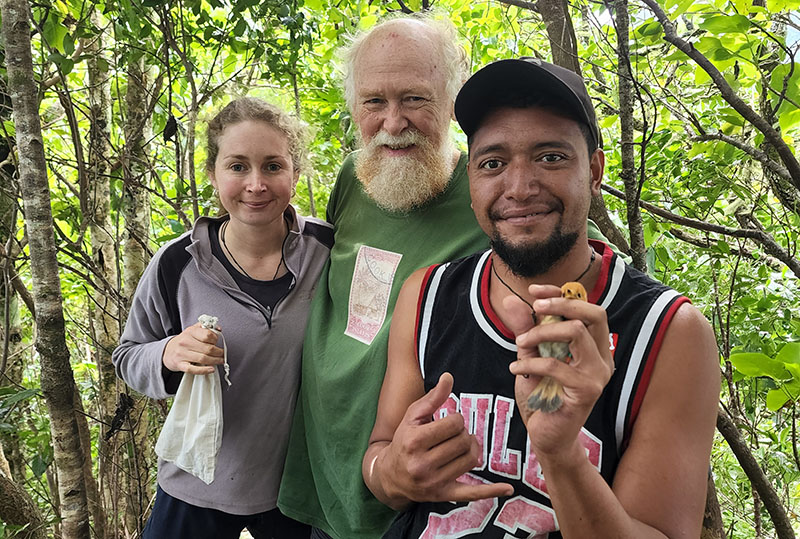Kakerori record breaking numbers
Saturday 27 August 2022 | Written by Te Ipukarea Society | Published in Opinion

Kate Simister, Hugh Robertson and Ieremia Samuela holding the 100th Kakerori caught for 2022. TIS/22082603
The Kakerori or Rarotonga Flycatcher found in the rugged interior of Rarotonga, as well as now on Atiu, has conservationists flapping with joy from this year’s Kakerori census, writes Alanna Smith of Te Ipukarea Society.
The census, which will come to an end in early September, was able to record its record breaking 100th Kakerori caught in a year. The previous record was 62 caught in 2018, prompting massive recognition for what has been a successful conservation project. The small flycatcher which has orange feathers from the age of 0-3 and grey feathers from four years old was close to extinction in 1989 when only 29 Kakerori were recorded in the world.
Invasive species, mainly the ship rat, were the main cause of the Kakerori’s near extinction. Ship rats are able to climb up trees, getting into nests to get at eggs and chicks. Feral cats are also likely predators of adults. The near extinction of the Kakerori saw the urgent action of an experimental rat poisoning programme in 1989 covering an area of 15 ha of the upper Totoko’itu catchment within what is now called the Takitumu Conservation Area (TCA).
Fly forward to 2001. An annual census found that the Kakerori population had increased at an average rate of 20 per cent per year from 29 birds to 255 birds. This is when Kakerori were introduced to Atiu as an insurance population in case a disaster hit the growing population on Rarotonga. In 2007, the annual census switched to a biennial census (every two years) to minimise costs as it was becoming too expensive and time consuming to maintain annually. The last census, in 2017, found 474 birds, and so the big hope is that the Rarotongan population has now passed 500 birds.
Having found that breeding success had improved over the years as a result of the rat baiting programme, the protected area gradually increased with time. Rat baiting rounds now cover the 155 ha of the TCA.
The annual rat baiting programme runs from September through to December to coincide with the time Kakerori start to pair up and make nests. Rat baiting, involves the dedicated work of local volunteers who trek the rugged interior of the TCA, completing each baitline once a fortnight. Rat bait is placed in bait stations every 25 metre along the various tracks that are meandering through the TCA.
To contribute to the census, it is necessary to be able to identify as many birds as possible. To do this, Kakerori are caught and those with no bands are “dressed” with a unique pattern of coloured plastic bands. The birds are caught by setting up a mist net made of fine nylon that’s very hard to see, at known Kakerori sites. Kakerori are territorial and curious birds and are attracted to noise in their area. Because of this behaviour, speakers are used to project the calls of Kakerori to draw the birds into the invisible net. When caught, Kakerori are safely removed, and are then weighed and measured to help identify a male from a female, and are banded around their tarsus (lower legs) for ID purposes.
Hugh Robertson from the Department of Conservation (DOC) has played an instrumental role in the Kakerori census work carried over the years. Not only has Hugh been able to collect and record such valuable data for 30-plus years, he also does what he can to upskill local conservationists in census activities such as mist netting and colour banding.
Te Ipukarea Society were fortunate enough to have been present for the 100th Kakerori caught for 2022. Kate Simister, also from DOC has been assisting Hugh in the 2022 census. Both Hugh and Kate have endured sometimes 10-hour days up in the TCA, day after day of trekking, patiently waiting, and recording Kakerori in the forever changing weather conditions Rarotonga has recently offered.
Hugh remembers the time when the Kakerori population passed 100 birds in 1994. To now catch 100 in the mist nets over the space of two months in 2022, was a special moment for all involved in the efforts to bring the Kakerori back from the brink of extinction.
Data taken from: Robertson et al. 2020. Takitumu Conservation Area Management Plan 2020-2030.














































